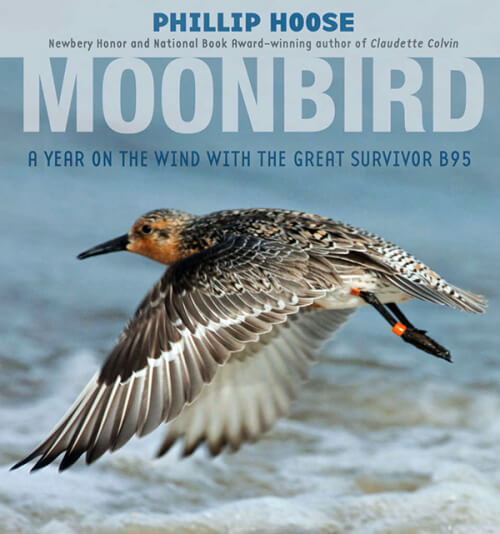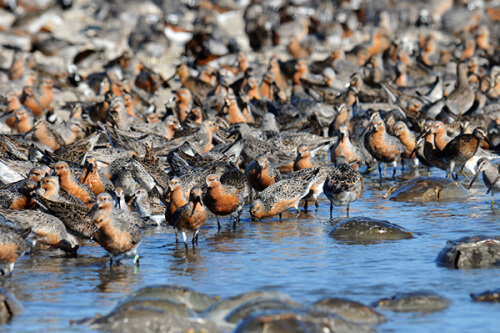Avian Methuselah: Celebrated Red Knot Keeps on Trucking
The rufa Red Knot called B95 or “Moonbird” may be the most famous bird on Earth. I can't think of any other wild bird that has its own biographer (Philip Hoose, author of “Moonbird.”) Nor am I aware of any other single bird that has its own statue (at the Mispillion Harbor Reserve near the town of Milford, Delaware.)
Incredible Survivors
Moonbird is the only bird I know of that makes headlines by not dying. This is as it should be, since B95 is living proof that migratory birds can be incredible survivors.

The long-lived Red Knot with the tag B95, known as “Moonbird,” has become famous enough to merit its own biography.
Every year, B95 flies back and forth between its Artic breeding grounds and wintering spots in southern South America, traveling approximately 10,000 miles in the process. That's a truly stunning feat, but it is not the thing that makes Moonbird so special.
What makes Moonbird special is the fact that while the lifespan of the average rufa Red Knot is about five years, this knot has been on the wing for 19 years, at least.
In that time, the cumulative distance travelled by B95 is thought be much greater than the distance to the moon. Hence the nickname Moonbird, and the widespread awe that comes with each new sighting.
In 2013, a Moonbird sighting came from Tierra del Fuego, Argentina. There the bird was picked out of a flock of roughly 100 Red Knots gathered on a beach. Patricia M. Gonzales of the Global Flyway Network identified the bird through binoculars.
Gonzales told the New York Times that her hands started shaking when she recognized the badly faded orange tag attached to Moonbird's right leg.
In 2014, the bird was once again spotted in New Jersey and on its Arctic breeding grounds. As of December 2016, we have not heard of additional sightings since that time. And National Geographic has since published information on a worrisome trend among young Red Knots still on their Arctic breeding grounds: the birds are smaller and probably less travel-worthy than their larger, healthier forbears.
Plummeting Populations
Sightings of this legendary bird are almost always used to draw attention to an ugly trend line, one that shows that rufa Red Knot populations have been plummeting for decades. Widespread loss of habitat and overfishing of the once-abundant horseshoe crabs that converge on the Delaware Bay each spring to lay millions of eggs, are leading to its decline. Now climate change seems to be playing a part.
Still, flocks of migratory Red Knot almost always reach the bay as the horseshoe crab egg-laying begins. The chaotic feast that follows is amazing, but much smaller than it used to be.

Red Knots and other shorebirds converge on the shores of the Delaware Bay each spring by the thousands to feast on horseshoe crabs eggs, re-building their fat stores to finish the long migration to Arctic breeding grounds. Photo by Gregory Breese, USFWS
There are still a few new rays of hope for the survival of the species. One comes from the U.S. Fish and Wildlife Service, which has added the rufa Red Knot to the list of plants and animals protected by the U.S. Endangered Species Act.
Another comes from field teams that count Red Knots in the Delaware Bay each spring. In 2012, they reported that the Red Knot population had held steady from the year before. We don't know if that trend has held, and the reason for it. But that's still much better than sharp declines that have long been the norm.
No one doubts that there's a huge amount of work that must be done if we're to bend this ugly trend line upward. We'll need to be stubborn and we'll need to find our way around all kinds of obstacles and threats.
We need to be more like Moonbird.
 John Nielsen was Senior Writer/Editor at ABC and a former Environment Correspondent at National Public Radio. In 2006 his book Condor/To the Brink and Back/The Life and Times of One Giant Bird won the National Outdoor Book Award for Natural History Literature.
John Nielsen was Senior Writer/Editor at ABC and a former Environment Correspondent at National Public Radio. In 2006 his book Condor/To the Brink and Back/The Life and Times of One Giant Bird won the National Outdoor Book Award for Natural History Literature.


















































